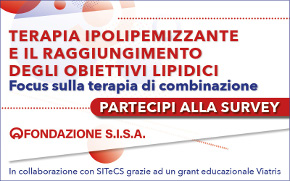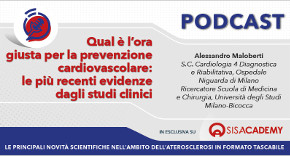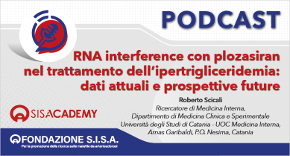 Rivista in lingua italiana
Rivista in lingua italiana
riservata ai Soci SISA
Ultimo numero:
Anno 16 • N.1/2025
SISANews
Parlare di più con il paziente migliora l'aderenza alla terapia
E' ben noto che uno dei problemi maggiori nella terapia cronica sia rappresentato dall'aderenza al protocollo terapeutico. Aderenza che diventa ancora più problematica quando si tratta di terapie, come quelle con farmaci ipolipidemizzanti, ma anche con ipotensivi, che non hanno un impatto immediato sullo stato di salute. E' stato ampiamente documentato che dopo pochi mesi dall'inizio della terapia con statine, la maggior parte dei pazienti o smette di assumere la terapia, o la assume a dosi più basse di quelle prescritte, o la assume irregolarmente. Il problema è rilevante dato che il mancato raggiungimento degli obiettivi terapeutici vanifica o riduce fortemente l'efficacia preventiva. Lo studio di Nieuwkerk ha dimostrato che spendere un po' del proprio tempo per illustrare al paziente i principi della prevenzione, spiegare che la strategia deve tenere in considerazione il pannello dei fattori di rischio anche non lipidici e evidenziare i risultati ottenibili con la correzione dei fattori di rischio modificabili, ha un effetto positivo in termini di aderenza alla terapia, misurata con la variazione del profilo lipidico.
![]()
Intervention to improve adherence to lipid-lowering medication and lipid-levels in patients with an increased cardiovascular risk
Nieuwkerk PT, Nierman MC, Vissers MN, Locadia M, Greggers-Peusch P, Knape LP, Kastelein JJ, Sprangers MA, de Haes HC, Stroes ES
Am J Cardiol 2012;110:666-672
Low levels of statin adherence may compromise treatment outcomes. The aim of this study was to investigate whether nurse-led cardiovascular risk-factor counseling could improve statin adherence and lipid levels without increasing patients' anxiety. Patients with indications for statin therapy for primary or secondary prevention of cardiovascular disease were randomly assigned to receive routine care or extended care (EC) at baseline and at months 3, 9, and 18. Patients in the EC group received a personalized risk-factor passport, showing modifiable and unmodifiable individual risk factors and a graphical presentation of their calculated absolute 10-year cardiovascular disease risk as well as the target risk that could be reached if all modifiable risk factors were optimally treated. Lipid levels were assessed at each visit. Carotid intima-media thickness was measured at baseline and at month 18. Adherence, anxiety, quality of life, symptoms, and smoking status were assessed using a self-administered questionnaire at each visit. A total of 201 patients were included in the study. Statin adherence was significantly higher (p <0.01) and anxiety was significantly lower (p <0.01) in the EC group than in the routine care group. Low-density lipoprotein cholesterol was statistically significantly lower in the EC group than in the routine group (2.66 vs 3.00 mmol/L, respectively, p = 0.024) in primary prevention patients only. Intima-media thickness improved significantly from baseline (p <0.01) in all patients, irrespective of group assignment. In conclusion, cardiovascular risk-factor counseling resulted in improved lipid profiles in primary prevention patients and higher levels of adherence to statins and lower levels of anxiety in all patients.

Area Soci
Eventi
39° Congresso Nazionale
 39° Congresso Nazionale
39° Congresso NazionaleRoma, 23-25 novembre 2025
Save the date




 Spring Meeting Gruppi Giovani SID, SIGG, SIIA, SIMI, SIPREC, SISA
Spring Meeting Gruppi Giovani SID, SIGG, SIIA, SIMI, SIPREC, SISARimini, 6-8 aprile 2025
[continua a leggere]
 SISA LIPID ACADEMY - Corso avanzato di lipidologia clinica
SISA LIPID ACADEMY - Corso avanzato di lipidologia clinicaModena, 4-5 Luglio 2024
[continua a leggere]Giornale Italiano Arteriosclerosi
HoFH today
 Rivista Italiana della
Rivista Italiana della
Ipercolesterolemia
Familiare Omozigote
Anno 6 • N.1/2024
Rivista NMCD
Diateca
[continua a leggere]
[continua a leggere]
Newsletter
il vostro indirizzo di posta elettronica
Progetto LIPIGEN

Nuovo sito dedicato al Progetto LIPIGEN
Progetto LIPIGEN - Vecchio portale
E' necessario essere loggati come utente
Lipigen per poter accedere alla pagina
PROject Statin Intolerance SISA
PROSISA – PROject Statin Intolerance SISA
E' necessario essere loggati come utente
PROSISA per poter accedere alla pagina
GILA - Lipoprotein Aferesi
Gruppo Interdisciplinare Lipoprotein Aferesi
(Accesso Gruppo GILA-Lipoprotein Aferesi)
E' necessario essere loggati come utente del Gruppo GILA per poter accedere
Gruppo Interdisciplinare Lipoprotein Aferesi
(Documentazione ad accesso libero)
Pagina informativa per medici e pazienti










